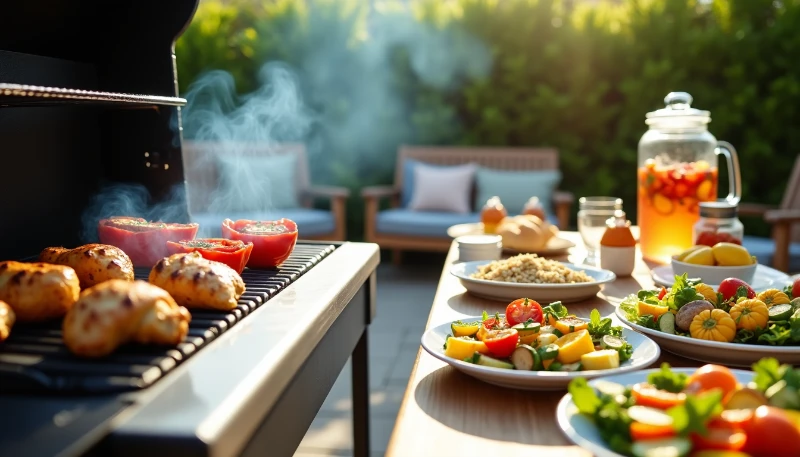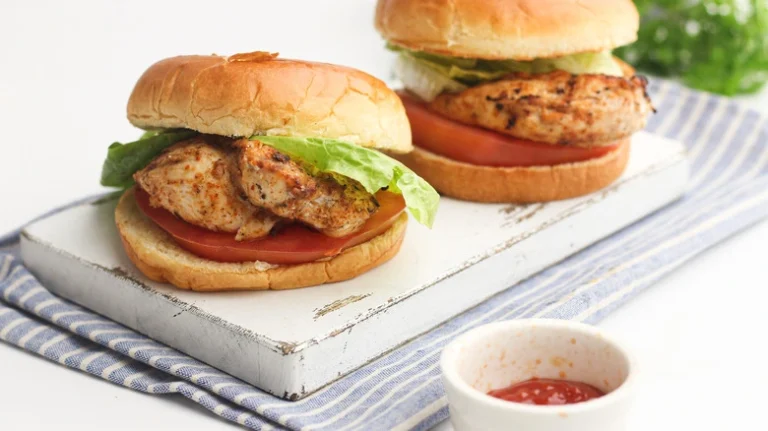How to Host a Healthy Cookout Menu That Even Food Lovers Can’t Resist
Americans will spend a staggering $9.5 billion on cookout food during the Fourth of July holiday. Most of this money goes toward high-calorie burgers, steaks, and hot dogs. These traditional cookout foods delight our taste buds but leave us feeling stuffed and regretful about our choices. Opting for a healthy cookout menu can provide a delicious alternative without the guilt, offering lighter yet flavorful options.
We found that there was a better way to enjoy cookout food without sacrificing flavor or fun. Fresh vegetables and smart protein swaps can help us create tasty dishes with less than 200 calories per serving. Your cookout can reshape the scene into a health-conscious feast that food lovers will appreciate, whether you’re hosting a neighborhood gathering or a family celebration.
Cookout menu with latest prices 2025 .
Planning Your Healthy Cookout Menu
A balanced menu is the foundation of any successful healthy cookout. The secret lies in mixing crowd favorites with nutritious alternatives that keep everyone happy.
Balance between classics and healthy options
The best cookout menus blend beloved classics with lighter choices. To name just one example, you can serve grilled vegetables with herb dressing next to traditional burgers for extra flavor. Cold sides and refreshing salads complement grilled mains perfectly.
Portion sizes and serving suggestions
The right portion sizes will give a healthy balance to your cookout. Each guest needs 6-8 ounces of protein per person for main dishes. Your well-laid-out plate should look like this:
- Half the plate for vegetables and salads
- Quarter plate for lean proteins
- Quarter plate for whole grains
- Small portion of healthy fats in the center
Accommodating dietary restrictions
Your guests will feel welcome when you understand and accommodate their dietary needs. We asked guests about their food priorities beforehand. Vegetarian guests deserve more than just side salads. Clear ingredient labels help guests make informed choices about what they eat.
Food safety matters too. Use separate utensils and prep areas for different dietary options. This integrated approach lets all but one of these guests join the fun without worry, whatever their dietary needs.
Smart Ingredient Swaps for Popular Dishes
You can make your cookout favorites healthier by choosing the right ingredients. Simple swaps can cut calories by a lot while keeping all the flavors we love. Incorporating a healthy cookout menu ensures that you enjoy classic dishes with a nutritious twist, from lean proteins to fresh, wholesome sides.
Lean protein alternatives
Skinless white poultry meat is a great protein choice that packs approximately 30g of protein per 3.5 oz serving. Grilled salmon has become a nutritionist’s favorite because it’s rich in heart-healthy omega-3 fatty acids. The core team also loves lean ground turkey as a burger alternative. We used varieties labeled “lean” that don’t include dark meat and skin.
Healthier marinades and sauces
Great marinades are the foundations of flavorful, healthy dishes. Here’s my go-to mix for chicken:
- Fresh lime juice and zest
- Olive oil
- Fresh cilantro
- Garlic
- Salt and pepper
These ingredients improve flavor and keep meat moist. A healthier BBQ sauce alternative combines tomato sauce, maple syrup, and apple cider vinegar as the base. My homemade version contains half the calories of store-bought options.
Vegetable-based sides
Cauliflower works great instead of traditional potato salad and gives you the same texture with fewer carbs. There’s another reason to try rutabagas instead of potatoes – they have only 5 grams of net carbs per serving. A watermelon-cucumber salad with fresh basil brings the perfect balance of sweet and savory flavors to your table.
Setting Up Your Cookout Space
Smart space planning makes the most important difference when you host a successful healthy cookout. We recommend placing food stations about 20 feet away from cooking and seating areas.
Food station organization
Your food station’s layout just needs careful thought. Tables placed in shaded spots will prevent food from spoiling and keep your guests comfortable. The dishes should flow in a logical order – start with plates and utensils, move to cold items, and end with hot dishes.
Healthy appetizer placement
Fresh, nutritious appetizers should take center stage at your cookout. Create a dedicated space for seasonal vegetables and fruits right at the start of the food line. Temperature-sensitive items like dips and cheese plates stay fresh when you use marble or granite serving pieces that you can freeze ahead of time.
Drink station setup
A well-laid-out drink station helps guests stay hydrated and supports your cookout’s healthy theme. Here’s everything in a functional beverage area:
- Clear glass dispensers for visibility
- Separate sections for alcoholic and non-alcoholic options
- Fresh fruit garnishes in wire baskets
- Ice bucket for keeping drinks chilled
Water dispensers should sit at the front of the drink station. You can improve plain water with sliced citrus fruits or crushed berries that add a refreshing twist. This smart setup will give your guests easy access to healthy drink choices throughout the cookout.
Grilling Techniques for Healthier Results
Learning to grill properly will ensure safety and bring out the best flavors in your healthy cookout dishes. We focused on temperature control and cooking times to prevent harmful compounds from forming while keeping the nutrients intact.
Temperature control basics
The right grill temperature depends on proper damper management. High heat (450-550°F) needs the top lid damper wide open, while medium heat (350-450°F) works best with the damper half open. Low and slow cooking (225-275°F) requires the damper to be quarter or eighth open. The best temperature control comes from keeping bottom dampers fully open and adjusting the top lid damper.
Proper cooking times
Getting the timing and temperature right is vital to food safety. Here’s what you need to know:
- Beef and lamb: Cook to 140°F for medium-rare, 155°F for medium
- Ground meats: Must reach 165°F for food safety
- Poultry: Ensure internal temperature of 165°F
- Fish and seafood: Cook for shorter periods, typically 20 minutes to a few hours
Roasts and thick cuts need 5-10 minutes of rest time. The internal temperature will rise by 5-10 degrees during this period.
Using marinades effectively
Marinades do more than just add flavor. Understanding how to use them is a vital part of grilling. Use about ½ cup of marinade or 1 tablespoon of spice rub for each pound of food. Different proteins need different marination times:
- Tender beef cuts: 15 minutes to 2 hours
- Less tender beef cuts: Minimum 6 hours
- Poultry and cubed meat: Up to 2 days
- Beef, veal, pork, lamb cuts: Up to 5 days
Food safety is paramount – never reuse marinade that has touched raw meat. Keep all food in the refrigerator during the marination process.
Conclusion
My years of hosting cookouts have taught me that healthy outdoor gatherings can be better than traditional ones with the right planning and smart choices. The right menu balance, smart food station setup, and becoming skilled at grilling techniques will give guests an experience that pleases both health-conscious eaters and food lovers.
Smart protein alternatives and fresh vegetable sides are the life-blood of a successful healthy cookout. Some hosts worry about how guests might react, but I’ve seen well-prepared, nutritious options become the most popular dishes at these gatherings.
Good temperature control and precise timing can turn basic ingredients into unforgettable meals. Traditional cookouts often leave guests feeling tired, but a comprehensive approach lets everyone enjoy the celebration fully. The path to success combines great recipes with proper food handling, organized stations, and perfect timing.
A healthy cookout combines amazing food with mindful eating. These techniques and tips will help you create gatherings that your guests will love and want to recreate at home.
FAQs
Q1. What are some healthy alternatives to traditional cookout foods?
Grilled vegetables like mushrooms, zucchini, and peppers are excellent healthy options. Lean proteins such as skinless chicken or grilled salmon are nutritious choices. For sides, try a watermelon-cucumber salad or cauliflower “potato” salad for lower-carb alternatives.
Q2. How can I ensure my cookout is enjoyable for all guests?
Plan a balanced menu with both classic and healthy options. Accommodate dietary restrictions by offering vegetarian choices and clearly labeling ingredients. Set up food stations strategically, including a dedicated area for fresh appetizers. Don’t forget to provide entertainment like music or outdoor games.
Q3. What are some tips for grilling healthier meals?
Master temperature control by adjusting grill dampers for different heat levels. Use proper cooking times and temperatures for various meats to ensure food safety. Utilize marinades effectively to enhance flavor and tenderness, but always discard used marinade for safety reasons.
Q4. How can I control portion sizes at a cookout?
Plan for 6-8 ounces of protein per person. Aim for a balanced plate with half vegetables and salads, a quarter lean protein, and a quarter whole grains. Use smaller plates to encourage moderation and place healthier options at the beginning of the food line.
Q5. What are some creative ways to make healthy cookout food more appealing?
Experiment with flavorful, low-calorie marinades using ingredients like lime juice, herbs, and spices. Offer colorful vegetable skewers or fruit kebabs for visually appealing options. Create a DIY toppings bar with fresh herbs, sliced vegetables, and homemade sauces to let guests customize their meals.







